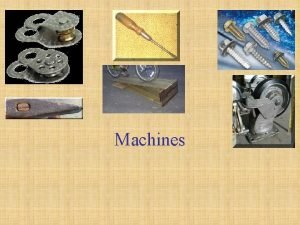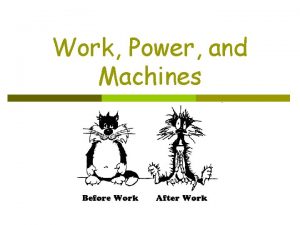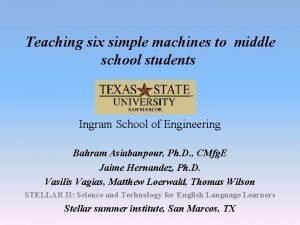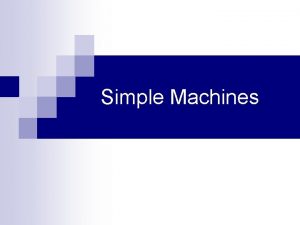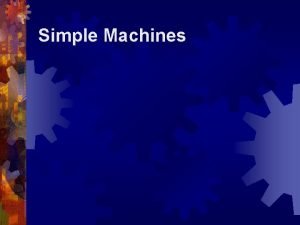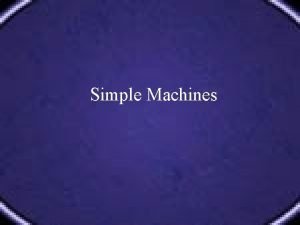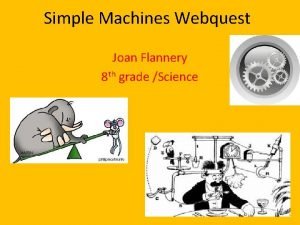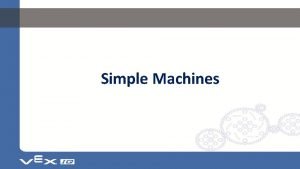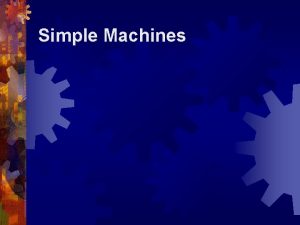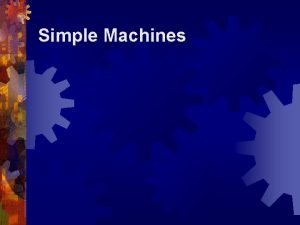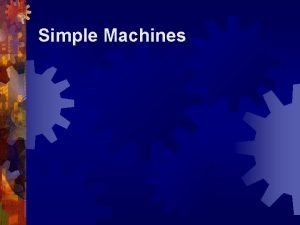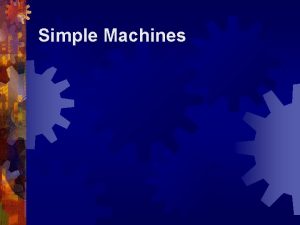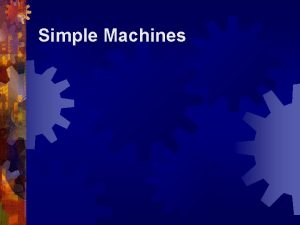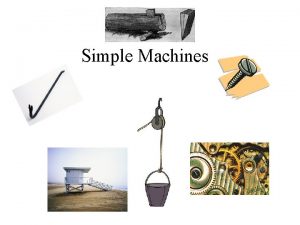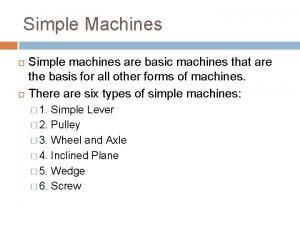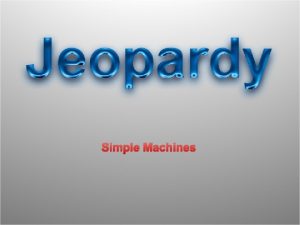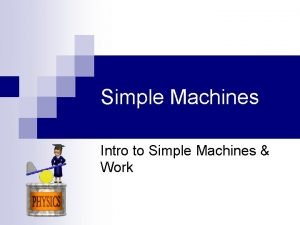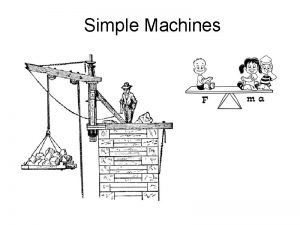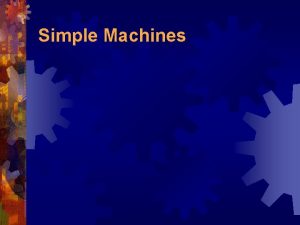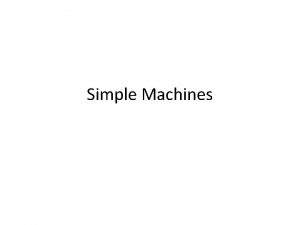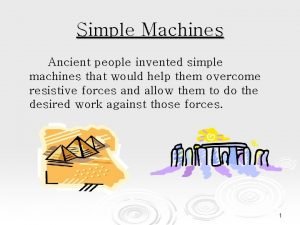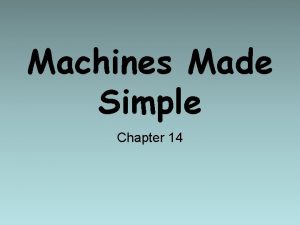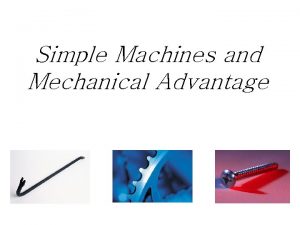Machines Simple Machines Have few or no moving

























- Slides: 25

Machines

Simple Machines • Have few or no moving parts • Make work easier • Can be combined to create complex machines • Six simple machines: Lever, Inclined Plane, Wheel and Axle, Screw, Wedge, Pulley

Machines • Make work easier by: 1) decreasing force by increasing distance 2) increasing force by decreasing distance 3) force and distance stay the same but the direction is different.

Machines Make Work Easier by:

Mechanical Advantage • We know that a machine multiplies whatever force you put into it: - Using a screwdriver to turn a screw - Twisting a nail with pliers - Carrying a box up a ramp instead of stairs • The amount that the machine multiplies that force is the mechanical advantage of the machine • Abbreviated MA

Mechanical Advantage • (IMA) Ideal MA: This is the MA of a machine in a world with no friction, and no force is lost anywhere • (AMA) Actual MA: This is simply the MA of a machine in the world as we know it - Force is lost due to friction - Force is lost due to wind, etc. • Can we have an ideal machine?

Mechanical Advantage MA = output force input force IMA = input distance output distance Ø Mechanical advantage is a ratio so there is no unit.

Efficiency • The efficiency is a ratio that measures how much work the machine produces versus how much work goes in • Example: We have an inclined plane with an ideal MA of 3. We measure our real-life inclined plane and find an MA of 2. Efficiency = Actual MA/Ideal MA x 100% = (2/3) X 100% = 66. 66%

Inclined Planes • A slope or ramp that goes from a lower to higher level • Makes work easier by taking less force to lift something a certain distance • Trade off: the distance the load must be moved would be greater than simply lifting it straight up

Mechanical Advantage: Inclined Plane • The mechanical advantage of an inclined plane is the length of the slope divided by the height of the plane, if effort is applied parallel to the slope • So for our plane MA = 15 feet/3 feet = 5 • Let’s say S = 15 feet, H = 3 feet

Wedge • An inclined plane on its side • Used to cut or force material apart • Often used to split lumber, hold cars in place, or hold materials together (nails)

Mechanical Advantage: Wedge • Much like the inclined plane, the mechanical advantage of a wedge is the length of the slope divided by the width of the widest end • So for our wedge, MA = 6”/2” = 3 • They are one of the least efficient simple machines

Screw • An inclined plane wrapped around a rod or cylinder • Used to lift materials or bind things together

Mechanical Advantage: Screw • The Mechanical advantage of a screw is the circumference of the screwdriver divided by the pitch of the screw • The pitch of the screw is the number of threads per inch • So for our screwdriver MA = 3. 14”/0. 1” = 31. 4 Circumference = ∏ x 1” = 3. 14” Pitch = 1/10” = 0. 1”

Wheel and Axle • A larger circular wheel affixed to a smaller rigid rod at its center • Used to translate force across horizontal distances (wheels on a wagon) or to make rotations easier (a doorknob) • Trade off: the wheel must be rotated through a greater distance than the axle

Mechanical Advantage: Wheel and Axle • The mechanical advantage of a wheel and axle system is the radius of the wheel divided by the radius of the axle • So for our wheel and axle MA = 10”/2” = 5

Pulley • A rope or chain free to turn around a suspended wheel • By pulling down on the rope, a load can be lifted with less force • Trade off: no real trade off here; the secret is that the pulley lets you work with gravity so you add the force of your own weight to the rope

Mechanical Advantage: Pulley • The Mechanical Advantage of a pulley is equal to the number of ropes supporting the pulley • So for the pulley system shown there are 3 ropes supporting the bottom pulley MA = 3 • This means that if you pull with a force of 20 pounds you will lift an object weighing 60 pounds

Lever • A rigid board or rod combined with a fulcrum and effort • By varying position of load and fulcrum, load can be lifted or moved with less force • Trade off: must move lever large distance to move load small distance • There are 3 types of levers

st 1 Class Lever • The fulcrum is located between the effort and the load • Direction of force always changes • Examples are scissors, pliers, and crowbars

2 nd Class Lever • The resistance is located between the fulcrum and the effort • Direction of force does not change • Examples include bottle openers and wheelbarrows

3 rd Class Lever • The effort is located between the fulcrum and the resistance • Direction of force does not change, but a gain in speed always happens • Examples include ice tongs, tweezers and shovels

Mechanical Advantage: Lever • The mechanical advantage of a lever is the distance from the effort to the fulcrum divided by the distance from the fulcrum to the load • For our example, MA = 10/5 = 2 • Distance from effort to fulcrum: 10 feet • Distance from load to fulcrum: 5 feet

The trick is WORK • Simple machines change the amount of force needed, but they do not change the amount of work done • What is work? • Work equals force times distance • W=Fxd • By increasing the distance, you can decrease the force and still do the same amount of work

Examples: • Inclined Plane: • Lever: • Work is equal on both sides of a lever. You move the long end a LARGE distance with SMALL force. The other end moves a SMALL distance with a LARGE force, which is why it can lift heavy objects. • It takes a certain amount of work to get the cabinet into the truck. You can either exert a LARGE force to lift it the SMALL distance into the truck, or you can exert a SMALL force to move it a LARGE distance along the ramp.
 An inclined plane wrapped around a rod
An inclined plane wrapped around a rod Adverb of little
Adverb of little A few ja few ero
A few ja few ero Few a few little a little exercise
Few a few little a little exercise Complete the sentences. use the following words
Complete the sentences. use the following words 8 triangular faces
8 triangular faces Simple present simple past simple future exercises
Simple present simple past simple future exercises Present simple past simple future simple
Present simple past simple future simple Simple past simple present simple future
Simple past simple present simple future Past simple future simple present simple
Past simple future simple present simple Future simple examples
Future simple examples Present simple present continuous past simple exercises
Present simple present continuous past simple exercises Tenses chart for class 10th
Tenses chart for class 10th Definition present simple
Definition present simple Future simple present simple
Future simple present simple Find the efficiency of a machine that does 800 j
Find the efficiency of a machine that does 800 j What is a slogan?
What is a slogan? Types of wedges simple machines
Types of wedges simple machines Inclined planes examples
Inclined planes examples Slide is a simple machine
Slide is a simple machine Define compound machine
Define compound machine What type of simple machine is a lawn mower
What type of simple machine is a lawn mower Simple machine webquest
Simple machine webquest Simple machines study guide
Simple machines study guide Simple machines tools
Simple machines tools What are the six types of simple machines
What are the six types of simple machines
